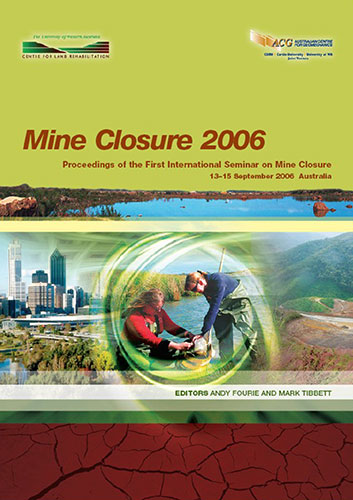A Risk Based Approach to Tailings Facility Closure ⎯ A Case Study

|
Authors: Luppnow, D; Boyce, S Paper is not available for download Contact Us |
DOI https://doi.org/10.36487/ACG_repo/605_60
Cite As:
Luppnow, D & Boyce, S 2006, 'A Risk Based Approach to Tailings Facility Closure ⎯ A Case Study', in AB Fourie & M Tibbett (eds), Mine Closure 2006: Proceedings of the First International Seminar on Mine Closure, Australian Centre for Geomechanics, Perth, pp. 689-696, https://doi.org/10.36487/ACG_repo/605_60
Abstract:
SRK Consulting (SRK) recently undertook the closure design for the Gold Bar tailings facility at the Atlas Gold Bar Mine, a defunct operation in central Nevada, USA. The tailing facility covers approximately 80 hectares (200 acres) (Figure 1) and is divided into three cells. This paper covers SRK’s approach to the closure design engineering and to the closure implementation while meeting State reclamation requirements. SRK’s approach to closure was guided by published papers and statics related to tailings failures, and also internal experience with having completed numerous other closure designs and closure construction, as well as closure and reclamation requirements for the State of Nevada. The closure design was performed in late 2005 while the implementation was undertaken in two time periods, namely during the winter of 2005/2006 and again the early summer of 2006.
References:
International Committee on Large Dams (ICOLD) (2001) Tailings Dams Risk of Dangerous Occurrence: Lessons learnt
from practical experiences (Bulletin No. 121).
Nevada Water Pollution Control Law, Nevada Revised Statues (NRS) (February 2003), 445A.430 through 445A.730.
Nevada Division of Environmental Protection (NDEP) Bureau of Mining Regulation and Reclamation (BMRR) (July
1999) Preparation Requirements and Guidelines for Permanent Closure Plans.
A Risk Based Approach to Tailings Facility Closure
― A Case Study
D. Luppnow, S. Boyce
696 Mine Closure 2006, Perth, Australia
© Copyright 2025, Australian Centre for Geomechanics (ACG), The University of Western Australia. All rights reserved.
View copyright/legal information
Please direct any queries or error reports to repository-acg@uwa.edu.au
View copyright/legal information
Please direct any queries or error reports to repository-acg@uwa.edu.au